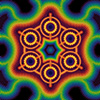Psilocybe Mexicana
Cultivation and analysis of Psilocybe Species and investigation of galerina steglichii by J. Gartz
in Ann. Mus. civ. Rovereto (1994) 297-306
Abstract:
Cultivation and formation of sclerotia of Psilocybe mexicana could be demonstrated on various grain substrates. Analysis of sclerotia from wet rice grain revealed the presence of psilocybin, in most cases psilocin and always low concentrations of baeocystin. - Psilocybin, psilocin and baeocystin levels varied in the blueing fruit bodies of the new species Psilocybe natalensis from South Africa (Anubis, look!) - The highest concentrations of these alkaloids were found in naturally grown and cultivated fruit bodies of Psilocye azurescens which is an indigenous species of the Pacific Northwest, U.S.A. - The relative alkaloidal content of psilocybin, psilocin and baeocystin found in Galerina steglichii (who has heard of this?) was similar to that measured in Psil. natalensis. Psilocybin was also found in the cultures blueing mycelium of these species.
From the text:
In Jan. 1994 we also found the first indigenous blueing Psilocybe species from South Africa on a field trip in the province Natal. This overall whitish and large species without a ring or even a velum grows on cow pastures and is named Psilocybe natalensis nom. prov. here. The alkaloid conc. in P.n. were very similar to the amounts in the subtropical and somewhat similar P.cubensis and in P.samuiensis from Thailand.
And on P.mexicana:
The strain of P.m. was obtained from the of the U.S.A. A successfull fruiting experiment on rye grass seed water mixture by using a casing layer (see Staments, the mushroom cultivator) confirmed the identity of the species. Cotton-pluuged 500 ml Erlenmeyer flasks were filled with 100g grain and 180 ml water, sterilized by autoclaving, cooled, inoculted from stock cultures and incubated at 23 C in darkness to promote the formation of sclerotia. Rye grain, soft rice grain and rye grass seed were used, respectively. It was founf that P.m. soon formed yellowish to brownish sclerotia on rye grass seed / water. Staments & Chilton reported similar grow patterns of sclerotia after 3 weks on the same substrate. In adition, the cultivation on soft rice grain /water also soon formed sclerotia after only 2 weeks. It was found that total darkness is not necessary for the formation of sc. on this substrate. Incubation of P.m. in diffuse daylight but without direct sunlight also promote this vegetative form. Sclerotia formation on rice grain (100g) / water after 2 months is 15-20g dry weight. The alkaloids levels obtained from these sclerotia were relatively high but varied even in the same batch. Larger sclerotia contained more psilocin than smaller agglomerationsIt seems that during the grow process a significant enzymatic decomposition of psilocybin to psilocin occured.. Only a few sclerotia were obtained on rye grain /water mixture after prolonged incubation (up to 12 weeks). It seems that the substrate based on soft rice grain was the best to promote regular formation of sclerotia in P. mexicana.
in Ann. Mus. civ. Rovereto (1994) 297-306
Abstract:
Cultivation and formation of sclerotia of Psilocybe mexicana could be demonstrated on various grain substrates. Analysis of sclerotia from wet rice grain revealed the presence of psilocybin, in most cases psilocin and always low concentrations of baeocystin. - Psilocybin, psilocin and baeocystin levels varied in the blueing fruit bodies of the new species Psilocybe natalensis from South Africa (Anubis, look!) - The highest concentrations of these alkaloids were found in naturally grown and cultivated fruit bodies of Psilocye azurescens which is an indigenous species of the Pacific Northwest, U.S.A. - The relative alkaloidal content of psilocybin, psilocin and baeocystin found in Galerina steglichii (who has heard of this?) was similar to that measured in Psil. natalensis. Psilocybin was also found in the cultures blueing mycelium of these species.
From the text:
In Jan. 1994 we also found the first indigenous blueing Psilocybe species from South Africa on a field trip in the province Natal. This overall whitish and large species without a ring or even a velum grows on cow pastures and is named Psilocybe natalensis nom. prov. here. The alkaloid conc. in P.n. were very similar to the amounts in the subtropical and somewhat similar P.cubensis and in P.samuiensis from Thailand.
And on P.mexicana:
The strain of P.m. was obtained from the


